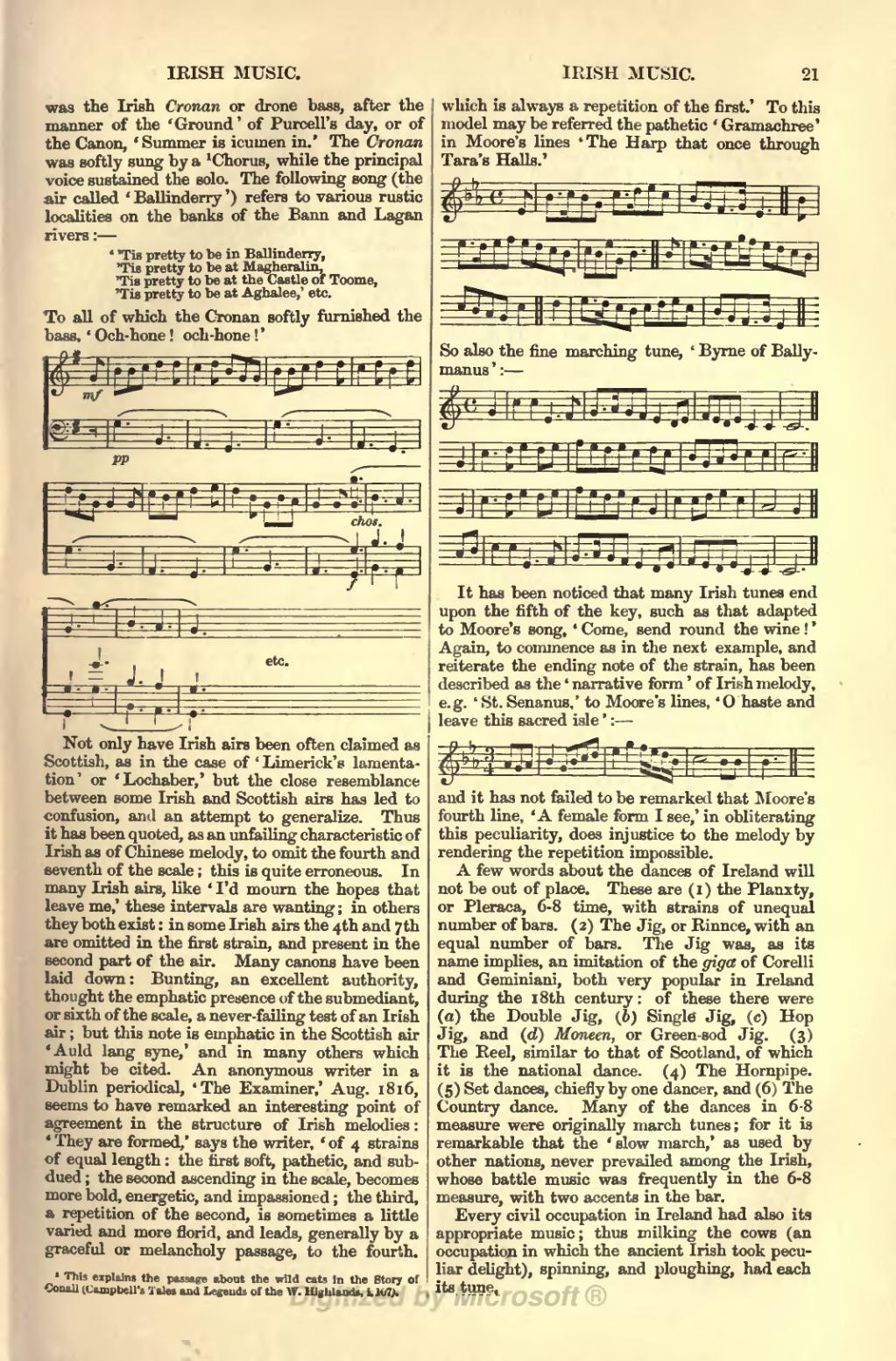was the Irish Cronan or drone bass, after the manner of the 'Ground' of Purcell's day, or of the Canon, 'Summer is icumen in.' The Cronan was softly sung by a [1]Chorus, while the principal voice sustained the solo. The following song (the air called 'Ballinderry') refers to various rustic localities on the banks of the Bann and Lagan rivers:—
''Tis pretty to be in Ballinderry,
'Tis pretty to be at Magheralin,
'Tis pretty to be at the Castle of Toome,
'Tis pretty to be at Aghalee,' etc.
To all of which the Cronan softly furnished the bass, 'Och-hone! och-hone!'

[App. p.685 "for chos read Chor"]
Not only have Irish airs been often claimed as Scottish, as in the case of 'Limerick's lamentation' or 'Lochaber,' but the close resemblance between some Irish and Scottish airs has led to confusion, and an attempt to generalize. Thus it has been quoted, as an unfailing characteristic of Irish as of Chinese melody, to omit the fourth and seventh of the scale; this is quite erroneous. In many Irish airs, like 'I'd mourn the hopes that leave me,' these intervals are wanting; in others they both exist: in some Irish airs the 4th and 7th are omitted in the first strain, and present in the second part of the air. Many canons have been laid down: Bunting, an excellent authority, thought the emphatic presence of the submediant, or sixth of the scale, a never-failing test of an Irish air; but this note is emphatic in the Scottish air 'Auld lang syne,' and in many others which might be cited. An anonymous writer in a Dublin periodical, 'The Examiner,' Aug. 1816, seems to have remarked an interesting point of agreement in the structure of Irish melodies: 'They are formed,' says the writer, 'of 4 strains of equal length: the first soft, pathetic, and subdued; the second ascending in the scale, becomes more bold, energetic, and impassioned; the third, a repetition of the second, is sometimes a little varied and more florid, and leads, generally by a graceful or melancholy passage, to the fourth, which is always a repetition of the first.' To this model may be referred the pathetic 'Gramachree' in Moore's lines 'The Harp that once through Tara's Halls.'

So also the fine marching tune, 'Byrne of Ballymanus':—

It has been noticed that many Irish tunes end upon the fifth of the key, such as that adapted to Moore's song, 'Come, send round the wine!' Again, to commence as in the next example, and reiterate the ending note of the strain, has been described as the 'narrative form' of Irish melody, e.g. 'St. Senanus,' to Moore's lines, 'O haste and leave this sacred isle':—

and it has not failed to be remarked that Moore's fourth line, 'A female form I see,' in obliterating this peculiarity, does injustice to the melody by rendering the repetition impossible.
A few words about the dances of Ireland will not be out of place. These are (1) the Planxty, or Pleraca, 6-8 time, with strains of unequal number of bars. (2) The Jig, or Rinnce, with an equal number of bars. The Jig was, as its name implies, an imitation of the giga of Corelli and Geminiani, both very popular in Ireland during the 18th century: of these there were (a) the Double Jig, (b) Single Jig, (c) Hop Jig, and (d) Moneen, or Green-sod Jig. (3) The Reel, similar to that of Scotland, of which it is the national dance. (4) The Hornpipe. (5) Set dances, chiefly by one dancer, and (6) The Country dance. Many of the dances in 6-8 measure were originally march tunes; for it is remarkable that the 'slow march,' as used by other nations, never prevailed among the Irish, whose battle music was frequently in the 6-8 measure, with two accents in the bar.
Every civil occupation in Ireland had also its appropriate music; thus milking the cows (an occupation in which the ancient Irish took peculiar delight), spinning, and ploughing, had each its tune.
- ↑ This explains the passage about the wild cats in the Story of Conall (Campbell's Tales and Legends of the W. Highlands, i. 167.
